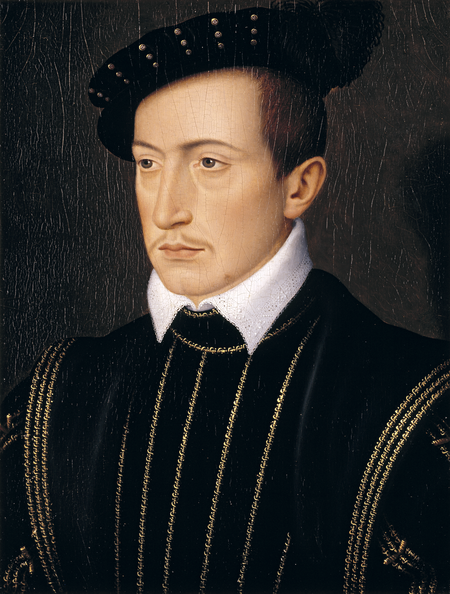Work of the Week #9
A modest portrait, one measuring about the size of a common sheet of paper, might be easily missed by visitors to the Timken’s French room. The fact that it is made by an artist known primarily for his depictions of sixteenth-century royalty doesn’t help it garner attention today. We generally aren’t drawn to stiff, early-modern types and who can blame us? This one’s dour expression won’t win him many “likes” on social media. Swipe left! Furthermore, in a space filled with imposing representations by the likes of Claude Lorrain, Jean-Honoré Fragonard, Jacques-Louis David, and Jean-Baptiste-Camille Corot, a smallish panel, no matter how finely rendered, is prone to being overlooked by the crowds that flock to the museum to enjoy its highly recognizable masterworks.
I confess that it took me a little while to warm up to François Clouet’s portrait of Guy XVII, Comte de Laval. Now, I can’t help but admire its meticulously drawn facial features and the mesmerizing details of his costume’s lacework and embroidery. My first really close look at the painting was inspired by a communication from a scholar raising questions about its attribution to Clouet. If you look up Guy XVII (known to his friends as Claude de Montfort-Laval) on Wikipedia, the Timken’s portrait is what you’ll see as his identifying image, however. I tell my students never to trust what they find on the internet, so I continue to puzzle over this question from time to time. The picture was first attributed to Clouet, and identified as being Guy XVII, by Agnes and Elizabeth Mongan, two sisters who were highly regarded as art historians. Agnes spent her professional life as a curator at Harvard’s Fogg Art Museum, eventually serving as that institution’s director from 1969 to 1971; Elizabeth also worked as a curator for important private collectors, but later taught art history at Smith College, and authored numerous exhibition catalogues of early prints and drawings for the Art Institute of Chicago and the National Gallery of Art. I would not presume to doubt their considerable expertise when it comes to 16th-century French things.
The Mongans’ belief that the Timken’s panel should be attributed to Clouet (c. 1516-1572) was based on connecting it, as only they might, to several autograph drawings of Guy XVII by the artist. One of those drawings was in a private collection in Cambridge, Massachusetts when the Mongan sisters advised the Putnam sisters to buy this picture back in 1955. Another work closely resembling it lives now at the Musée Condé, within the Chateau of Chantilly, near Paris. Both of those images on paper show a young man, maybe 18 years old, posed very like--but not strictly identical to--the sitter in our painting. The slight moustache, high hairline, large ear, and pronounced nose all look convincingly interchangeable. I am inclined to agree with the Mongans about most things and, in this case, don’t find much reason to doubt their attributions based on decades of connoisseurship and intense scholarly research.
What is of greater interest to me is the intersection of Claude de Monfort-Laval’s somewhat sad storyline with François Clouet’s contrastingly prosperous trajectory. If this work was completed around 1540, as the Mongans surmised, the artist would have been roughly 24 years old when he painted it. Clouet was not much older than the sitter, therefore. Both young men were then at crucial, if diverging, junctures in their lives: François had just replaced his father, Jean, as the First Painter to the King of France, and Claude, whose own father passed away not quite a decade before, leaving him with his formal title, had finally been given responsibility for what remained of his family’s once-substantial wealth. Both young men were Gentilhommes de la Chambre (Gentlemen of the King’s Bedchamber), a title given to the loyal group of courtiers who enjoyed close physical proximity to Francis I. Despite these obvious advantages, Claude received the short end of fate’s stick. He died just a few years after the three, closely-observed portraits Clouet made of him were finished. Today, it is unclear whether he was murdered because of his debts or he succumbed to some sudden, but equally deadly malady. In any case, Claude left no heirs and maybe that is why his tragic-looking likeness lost its clear identification. Clouet proceeded to become one of the most revered portraitists in Renaissance Europe. Take a good look at his inconspicuous, yet skillful work when you next visit the Timken. Hopefully, that won’t be long.
